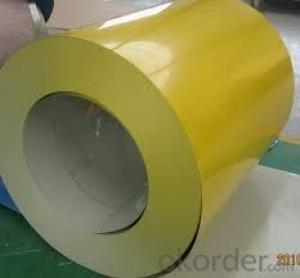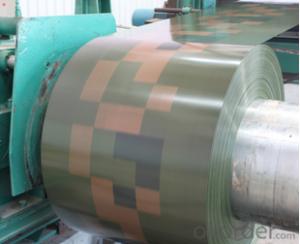Prepainted Steel Coil Without Anti-Dumping
- Loading Port:
- Shanghai
- Payment Terms:
- TT OR LC
- Min Order Qty:
- 20 m.t.
- Supply Capability:
- 10000 m.t./month
OKorder Service Pledge
OKorder Financial Service
You Might Also Like
Product Description
Description of Prepainted steel coils:
1) Standard: JIS G3312 CGCC & CGLCC, equivalent to ASTM A755M, EN10169
2) Grade: CGCC and CGLCC
3) Hardness of material: Both soft and full hard are available
4) Surface finish: With or without protect film covered
5) Thickness range: 0.14-1.20mm
6) Width range and General width: Width range 600-1250mm, general width: 914mm, 1000mm, 1220mm and 1250mm.
7) Shape: Both sheet and coil are available
8) Zinc coating: 60-275G/M2, both sides
9) Paint thickness: Top 5 um + (10-20) um modified polyester, any RAL color code. We use Beckers paint for producing.
10) Paint thickness: Reverse 5-10 um Epoxy
11) Coil weight: 4-6 tons, also can be upon customer's requirements
12) Max loading in one 20ft container: 25 tons generally
13) MOQ: 25 tons for each thickness or color;
14) Actual shipped quantity: More or less 5%;
15) Delivery time: 2 weeks or one month generally.
16) Applications: Widely used for roof tiles, outer walls, ovens, explosive-proof steel, electrically controlled cabinets, and industrial freezers in the residential and industrial buildings.
| Standard | JIS G3312 CGCC ASTM A755M EN10169 |
| Valid thickness | 0.20~1.20mm |
| Coil width | 600~1250mm |
| Coil ID | 508mm & 610mm |
| Coil weight | 3~5 tons |
| Zinc coating | 80~275 g/m2 |
| Thickness of top paint | 15~25 microns |
| Thickness of reverse paint | 5~7 microns |
| Color | any RAL code |
| Package | vertical, eye to sky & horizontal |
| MOQ | 25 tons |
- Q: What are the common methods of painting steel coils?
- The common methods of painting steel coils include coil coating, spray painting, and electrostatic painting.
- Q: What is the average lifespan of a steel coil?
- The average lifespan of a steel coil can vary depending on various factors such as its quality, usage, maintenance, and environmental conditions. However, on average, a well-maintained steel coil can last anywhere from 10 to 30 years.
- Q: How are steel coils used in the production of scaffolding?
- Scaffolding production heavily relies on steel coils as they serve as the primary raw material for manufacturing various components of scaffolding systems. These coils, typically composed of high-quality steel, are processed through cutting, shaping, and welding operations to obtain the desired dimensions and shapes for scaffolding components, including vertical and horizontal tubes, diagonal braces, and base plates. The main structural elements of scaffolding are the tubes and pipes formed from steel coils. These elements are responsible for constructing the framework of the scaffolding, comprising vertical uprights or standards, horizontal ledgers, and transoms that connect them. By providing strength, stability, and load-bearing capacity, these components ensure the safety of workers operating at elevated heights. Furthermore, diagonal braces, an essential part of scaffolding, are manufactured from steel coils. These braces are strategically installed diagonally between the vertical standards to reinforce the scaffolding structure, adding extra support and stability to prevent swaying or collapsing. Another crucial component produced from steel coils is the base plate. These plates serve as the foundation for the scaffolding structure, offering a solid and stable base to evenly distribute weight and load. Typically positioned at the bottom of each vertical standard, they play a vital role in maintaining stability and preventing sinking or sliding. To summarize, steel coils play a fundamental role in scaffolding production. Through their transformation into tubes, pipes, braces, and base plates, they form the framework and provide the necessary strength, stability, and load-bearing capacity for safe and efficient scaffolding systems.
- Q: I have hundreds of pounds of scrap steel... who purchases this steel and what is the price per pound etc. of this? Does someone pick it up or do I bring it somewhere?
- It okorder /
- Q: What are the common methods of protecting steel coils from corrosion during storage?
- Common methods of protecting steel coils from corrosion during storage include applying a protective coating or film, using desiccants or moisture-absorbing materials, implementing proper ventilation and climate control, employing corrosion inhibitors or VCI (Vapor Corrosion Inhibitors), and ensuring adequate packaging and sealing to prevent exposure to moisture or contaminants.
- Q: Steel resist tension. Then why we provide steel in compression zone ?
- There are several reasons to add compression steel. Keep in mind, supported steel (meaning it can't buckle) resists compression as well. Compression steel helps reduce long term deflections. Concrete creeps under sustained loads. Steel lessens the compression, meaning less sustained compressive stress to cause creep deflection. It makes members more ductile. Since the steel takes some of the compressive stress, the compression block depth is reduced, increasing the strain in the tension steel at failure, resulting in more ductile behavior (the moment at first yield remains largely the same with compression steel added, but the increase in capacity after yield is significant). Compression steel insures that the tension steel yields before the concrete crushes, meaning it helps change the failure mode to tension controlled. It makes beams easier to construct. With bars in the top and bottom, you have longitudinal reinforcement in all 4 corners of the shear stirrups to keep them in place when pouring the concrete. Also, for continuous members, its often easier to run your negative moment steel the full length of the beam rather than trying to cut it off in the positive moment regions. Serviceability concerns. You're going to end up putting steel in that region anyway to for temperature and shrinkage.
- Q: How are steel coils used in the production of automotive suspension systems?
- Steel coils are used in the production of automotive suspension systems as they provide the necessary support and flexibility to absorb shocks and vibrations. These coils are typically used in the construction of coil springs, which are then integrated into the suspension system to ensure a smooth and comfortable ride for the vehicle.
- Q: tinplate,hot rolled coil,hot rolled sheet,cold rolled coil,cold rolled sheet,d bar,wire rod,triangle,structural steel,steel pipe,steel tube,carbon steel pipe
- Here are the top 30 steel producing companies in the world, listed by the megaton output: 1. 63.0 Mton Mittal Steel Company NV (Global) [2] 2. 46.7 Mton Arcelor (Europe) [3] 3. 32.0 Mton Nippon Steel (Japan) [4] 4. 30.5 Mton POSCO (South Korea) [5] 5. 29.9 Mton JFE (Japan) [6] 6. 23.8 Mton Shanghai Baosteel Group Corporation (China) 7. 19.3 Mton United States Steel Corporation (United States) 8. 18.4 Mton Nucor Corporation (United States) 9. 18.2 Mton Corus Group (Europe) [7] 10. 17.5 Mton Riva Group (Europe) [8] 11. 16.5 Mton ThyssenKrupp (Europe) [9] 12. 16.1 Mton Tangshan (China) 13. 13.9 Mton EvrazHolding (Russia) 14. 13.7 Mton Gerdau (Brazil) 15. 13.6 Mton Severstal (Russia) 16. 13.5 Mton Sumitomo Metal Industries (Japan) 17. 13.4 Mton SAIL (India) 18. 12.0 Mton Wuhan Iron and Steel (China) 19. 11.9 Mton Anshan (China) 20. 11.4 Mton Magnitogorsk (Russia) 21. 10.5 Mton Jiangsu Shagang (China) 22. 10.5 Mton Shougang (China) 23. 10.4 Mton Jinan (China) 24. 10.3 Mton Laiwu (China) 25. 10.3 Mton China Steel (Taiwan) [10] 26. 9.6 Mton Maanshan 27. 9.4 Mton Imidro 28. 8.7 Mton Techint 29. 8.7 Mton Usiminas (Brazil) 30. 8.5 Mton Novolipetsk (Russia)
- Q: What are the factors affecting the formability of steel coils?
- The factors affecting the formability of steel coils include the composition and microstructure of the steel, the thickness and width of the coil, the temperature and speed of the forming process, the lubrication used during forming, and the presence of any surface defects or contaminants.
- Q: What is the process of uncoiling a steel coil?
- The process of uncoiling a steel coil involves feeding the coil into a machine called a decoiler. The decoiler holds the coil and gradually unrolls it, allowing the steel to be straightened and fed into downstream manufacturing processes. This is typically done by using a combination of motorized rollers and tension control systems to ensure a controlled and smooth uncoiling process.
Send your message to us
Prepainted Steel Coil Without Anti-Dumping
- Loading Port:
- Shanghai
- Payment Terms:
- TT OR LC
- Min Order Qty:
- 20 m.t.
- Supply Capability:
- 10000 m.t./month
OKorder Service Pledge
OKorder Financial Service
Similar products
Hot products
Hot Searches
Related keywords




























